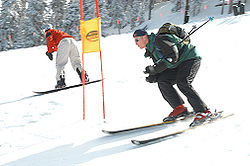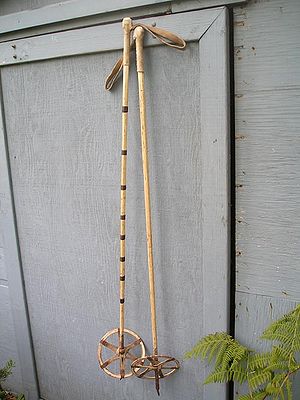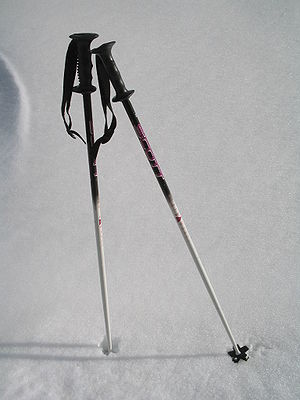
Ski pole
Encyclopedia

Skiing
Skiing is a recreational activity using skis as equipment for traveling over snow. Skis are used in conjunction with boots that connect to the ski with use of a binding....
to improve balance and timing. Early ski poles were simply sticks, then bamboo (1930s), then steel (1940s and early 1950s). In 1958, Ed Scott invented the aluminium ski pole. Now, composite ski poles are much lighter and stronger than aluminium poles, though aluminium poles are still one of the main types of ski pole on the market.
In the days before turning techniques had been properly developed, skiers would use poles for hunting: one pole would be for balance/braking and the other pole would have a sharpened tip or a spear head to be used as a spear.
In modern skiing one pole is held in each hand. Near the end of the shaft, there is a circular "basket" attached to stop the pole from sinking significantly into deep snow. These can range from being small, aerodynamic cones used in racing, to large snowflake shaped baskets which are used in powder skiing. Attached to the upper part of the pole is a grip with a strap, either fastened to the pole or detachable. These are usually slipped over the wrist to improve the skiers hold on the grip and to prevent the loss of the pole in the event of a fall. When skiing backcountry
Backcountry skiing
Backcountry skiing is skiing in a sparsely inhabited rural region over ungroomed and unmarked slopes or pistes, including skiing in unmarked or unpatrolled areas either within the ski resort's boundaries or in the backcountry, frequently amongst trees , usually in pursuit of fresh fallen powder...
(off piste), the wrist strap is not normally used, because there is a risk of wrist injury if the pole should catch on an unseen branch or root. Ski Jumping
Ski jumping
Ski jumping is a sport in which skiers go down a take-off ramp, jump and attempt to land as far as possible down the hill below. In addition to the length of the jump, judges give points for style. The skis used for ski jumping are wide and long...
, Ski Carving, Aerials
Freestyle skiing at the 2010 Winter Olympics – Men's aerials
The men's aerials event in freestyle skiing at the 2010 Winter Olympics in Vancouver, Canada took place on 22 February for the qualification round. The final was held on 25 February...
and Skiboarding
Skiboarding
Skiboarding is a winter sport which combines elements of skating, snowboarding, and skiing. Skiboards are used and worn in conjunction with standard ski boots that connect to the skiboards with use of a binding. Skiboards can be grouped into two general categories. Regular skiboards are generally...
are the only types of skiing in which no poles are used.


Cross-country and alpine ski poles
Poles are used in cross-country skiingCross-country skiing
Cross-country skiing is a winter sport in which participants propel themselves across snow-covered terrain using skis and poles...
to enable the user to gain more speed than by using the ski
Ski
A ski is a long, flat device worn on the foot, usually attached through a boot, designed to help the wearer slide smoothly over snow. Originally intended as an aid to travel in snowy regions, they are now mainly used for recreational and sporting purposes...
s alone, as well as offering improved balance. In Nordic
Nordic skiing
Nordic skiing is a winter sport that encompasses all types of skiing where the heel of the boot cannot be fixed to the ski, as opposed to Alpine skiing....
racing, poling technique is essential, especially so during a mass start in which double-poling is the main means of propulsion.
Alpine skiers
Alpine skiing
Alpine skiing is the sport of sliding down snow-covered hills on skis with fixed-heel bindings. Alpine skiing can be contrasted with skiing using free-heel bindings: Ski mountaineering and nordic skiing – such as cross-country; ski jumping; and Telemark. In competitive alpine skiing races four...
use poles as well. While they serve the same purposes as they do in cross country, they can also help with the timing of the more advanced ski turns. By making contact with the ground between each turn in a process known as "pole planting", alpine skiers are given greater stability as they move their mass down the hill, creating more acceleration and a tighter turning radius.
Pole sizing
There are certain methods to getting the right ski pole. For alpine skiing, the pole is placed with the grip on the ground. The skier then grips the pole right under the basket. The skiers elbow should form a right angleRight angle
In geometry and trigonometry, a right angle is an angle that bisects the angle formed by two halves of a straight line. More precisely, if a ray is placed so that its endpoint is on a line and the adjacent angles are equal, then they are right angles...
. If the skier's elbow is in a smaller angle the pole is too long, and if the skiers elbow is at an angle larger than 90 degrees, the pole is too short.
Longer poles are used for cross country because of different techniques. Pole length for classic (aka diagonal-stride) technique is typically measured from the ground to the skier's armpit. For skating (aka freestyle) technique the length of the pole is typically from the ground to the skier's upper lip. These length selections balance between maximum thrust and technique considerations. Most Nordic ski pole manufacturers have sizing charts available.
The shortest poles are used in Freestyle
Freestyle skiing
Freestyle skiing is form of skiing which used to encompass two disciplines: aerials, and moguls. Except the two disciplines mentioned earlier Freestyle Skiing now consists of Skicross, Half Pipe and Slope Style...
, but they can differ depending on the type of Freestyle. Poles used for ski touring
Ski touring
Ski touring is a form of backcountry skiing involving traveling over the winter landscape on skis under human power rather than through the assistance of ski lifts or snow vehicles. It can take place in terrain ranging from perfectly flat to extremely steep...
or Nordic Walking
Nordic walking
Nordic walking, originally known as ski walking, is a physical activity and a sport consisting of walking with poles similar to ski poles.-Origin:...
are telescopic, therefore they can be shortened or lengthened.
Alpine
In competitive alpine skiing, including high speed disciplines such as Giant Slalom, Super Giant Slalom, DownhillDownhill
Downhill is an alpine skiing discipline. The rules for the Downhill were originally developed by Sir Arnold Lunn for the 1921 British National Ski Championships....
, and Speed Skiing
Speed skiing
Speed skiing is the sport of skiing downhill in a straight line as quickly as possible. It is one of the fastest non-motorized sports on land. The current world record for skiing is 251.4 km/h , held by Simone Origone...
poles may be designed to bend around the skiers body while in a tuck position, in order to minimize air drag
Drag (physics)
In fluid dynamics, drag refers to forces which act on a solid object in the direction of the relative fluid flow velocity...
. In Slalom skiing
Slalom skiing
Slalom is an alpine skiing discipline, involving skiing between poles spaced much closer together than in Giant Slalom, Super-G or Downhill, thereby causing quicker and shorter turns.- Origins :...
, regular straight poles are preferred due to the reduced speeds and increased reliance on poles.
Nordic
Nordic ski poles (used for cross-country, biathlons, etc...) are longer than poles used for alpine skiing. Poles used for freestyle are longer than those used for classical skiing. Basket styles at the bottom of the pole vary by pole use. Back-country poles designed for use in deep snow will have a larger basket design, while a racing pole will have a small, lightweight basket.Back country or touring poles may be telescopic so they can be adjusted to snow conditions and/or the steepness of the slope.
Pole selection
There are a wide range of ski poles produced for many different styles and levels of skiing. Notable manufacturers of alpine and nordic poles include SwixSwix
Swix is a Norwegian company producing ski wax, ski poles and sportswear. The company is owned by the investment company Ferd AS, and has the head office in Lillehammer....
, Rossignol
Skis Rossignol
Skis Rossignol S.A., or simply Rossignol, is a French manufacturer of alpine, snowboard, and Nordic equipment, as well as related outerwear and accessories, located in Isère, France. Rossignol was one of the first companies to produce plastic skis. The company also owns the brand Dynastar as well...
, Alpina, Leki, Fischer, and K2
K2 Sports
K-2, Corporation. was founded in 1961 by brothers Bill and Don Kirschner on Vashon Island, near Seattle, Washington. K2 is known for pioneering fiberglass ski technology, which made skis significantly lighter and more lively than their wood and metal contemporaries...
. The cost of a ski pole can range from $20 for the least expensive recreational pole to hundreds of dollars for extremely light-weight racing poles. Some early ski poles were made from wooden or bamboo shafts, while modern poles are often made from lightweight aluminium tubing, fibreglass, and other specialized materials. In both Nordic and alpine skiing, lightweight composite materials have been used to reduce weight and increase the strength of the pole. Poles made of carbon fibre, or graphite
Graphite
The mineral graphite is one of the allotropes of carbon. It was named by Abraham Gottlob Werner in 1789 from the Ancient Greek γράφω , "to draw/write", for its use in pencils, where it is commonly called lead . Unlike diamond , graphite is an electrical conductor, a semimetal...
for instance, are very light and durable. There are also new materials such as AirFOIL used by Leki.
Technology used for wrist straps has improved as well, allowing more force from the skiier to be transferred to the pole. Some straps are designed to attach securely around a glove, secured with a hook and loop style closure system, i.e. Velcro
Velcro
Velcro is the brand name of the first commercially marketed fabric hook-and-loop fastener, invented in 1948 by the Swiss electrical engineer George de Mestral...
. Releasable strap systems have been implemented by pole manufacturers as well. For instance, the Trigger system used by Leki has the benefit of safety features that allow the pole to unhook from the straps it is connected to in the case of a crash.
Unipole
At the 1985 World Championships in Seefeld SwedishSweden
Sweden , officially the Kingdom of Sweden , is a Nordic country on the Scandinavian Peninsula in Northern Europe. Sweden borders with Norway and Finland and is connected to Denmark by a bridge-tunnel across the Öresund....
skier Gunde Svan
Gunde Svan
Gunde Svan is a former Swedish cross-country skier and auto racing driver. During his career he won a total of four gold, one silver and one bronze medals at the Winter Olympics...
brought his homemade 230cm ski pole and used it on a training day. Until this date FIS rules did not have a definition for ski poles during competition. Traditionally, ancient Scandinavian hunters skied with one very long ski pole, similar to the pole Svan brought to Seefeld. At this same time FIS was debating the introduction of the skating technique with many traditionalists arguing that it should not be allowed because historically it was not a used technique. Svan's use of the long ski pole was intended to point out the hypocrisy of the traditionalists' argument (ancient Scandinavians did a skating-like technique) . A side-effect of Svan's protest was a FIS definition for ski pole sizing which made this very long "unipole" not legal to use during a competition.
See also
- Skiing and skiing topicsSkiingSkiing is a recreational activity using skis as equipment for traveling over snow. Skis are used in conjunction with boots that connect to the ski with use of a binding....
- History of skiingHistory of skiingSkiing, or traveling over snow on wooden runners, has a recorded history of almost five millennia.- Ancient history :The first hints to the existence of skis are on 4500 to 5000 year old rock drawings, e.g. at Rødøy in Norway or at Steinkjer , which depict a man on skis holding a stick...
- Ski Pole History
- Ski Pole Size Chart

